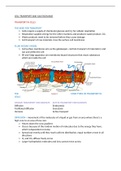Summary
Topic 4 summary notes (A Level Biology Edexcel B)
- Course
- Institution
- Book
This document contains summarised notes for Topic 4 Exchange and transport, taken using the Pearson Edexcel B biology activate textbook. Notes taken with referencing to specification.
[Show more]




